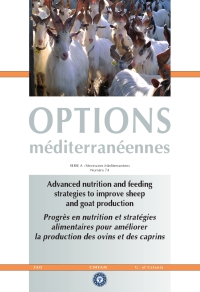| Article précédent | p. 129-134 | Article suivant |
Effect of different feeding systems on fatty acid composition and volatile compound content in goat milk
A survey was carried out on three Sarda goat herds (A, B and C) during the milking period, with the aim to investigate the effect of different feeding systems on milk composition, with particular emphasis to fatty acid (FA) and volatile compound contents. Herd A was stall-fed with hay and concentrate whereas herds B and C were fed at pasture, with woody and herbaceous species in B and only herbaceous species in C. Milk yield and composition including FA and volatile compounds, as well as feeding behaviour were measured monthly. Individual milk yield and composition were different in the three herds (P<0.05), as well as the bulk milk FA composition, particularly the long chain fatty acids (C17:0-C18:3). The levels of CLA (C18:2 c-9, t-11) and vaccenic acid (C18:1 t-11) were higher in B (11.10±0.9 and 23.01±1.9 g/kg of fat respectively; P<0.05) as compared to the other herds. When pooling all data, a relationship was found between CLA and vaccenic acid (Y=0.38X+1.90, R2
Trois troupeaux de chèvres Sardes (A, B et C) ont été suivis afin d'évaluer l'effet de différents systèmes alimentaires sur la production et la composition du lait, en particulier en acides gras et en composés volatils. Le troupeau A était alimenté en stabulation avec du foin et du concentré, alors que les troupeaux B et C s'alimentaient au pâturage, constitué d'espèces ligneuses et herbacées en B et d'espèces exclusivement herbacées en C. La production et la composition du lait, y compris les acides gras et les composés volatils, ainsi que le comportement alimentaire des animaux, furent mesurés une fois par mois. Une différence significative (P<0,05) de production et de composition du lait a été observée entre les trois troupeaux ainsi qu'au niveau de la composition en acides gras, en particulier ceux à longue chaîne (C17:0-C18:3). Les niveaux de CLA (C18:2 c-9, t-11) et d'acide vaccénique (C18:1 t-11) étaient plus élevés pour le troupeau B (respectivement 11,10±0,9 et 23,01±1,9 g/kg de matière grasse; P<0,05). Enfin, une bonne relation entre teneur en CLA et acide vaccénique a été trouvée (Y=0,38X+1,90, R2=0,79, P<0,05). La différence de profil des composés volatils totaux entre les trois troupeaux est probablement due à l'effet de différents régimes alimentaires.
- [ Afficher ]
- [ Télécharger ]
- [ Exporter la citation ]
Vous pouvez télécharger la citation au format :
- [ Imprimer ]
-
Mots-clés
ACIDE GRAS, CHEVRE, EXPERIMENTATION, LAIT DE CHEVRE, PATURAGE, QUALITE, REGIME ALIMENTAIRE, STABULATIONCiter cet article
Decandia M., Cabiddu A., Molle G., Branca A., Epifani G., Pintus S., Tavera F., Piredda G., Pinna G., Addis M. Effect of different feeding systems on fatty acid composition and volatile compound content in goat milk. In : Priolo A. (ed.), Biondi L. (ed.), Ben Salem H. (ed.), Morand-Fehr P. (ed.). Advanced nutrition and feeding strategies to improve sheep and goat . Zaragoza : CIHEAM, 2007. p. 129-134. (Options Méditerranéennes : Série A. Séminaires Méditerranéens; n. 74). 11. Seminar of the FAO-CIHEAM Sub-Network on Sheep and Goat Nutrition, 2005/09/08-10, Catania (Italy). http://om.ciheam.org/om/pdf/a74/00800367.pdf



